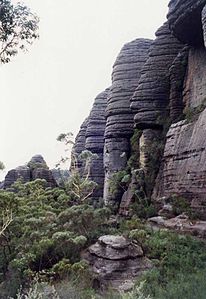Budawang Range
| Budawang Range | ||
|---|---|---|
|
The Seven Gods Monoliths |
||
| Highest peak | Mount Budawand ( 1129 m ) | |
| location | New South Wales | |
| part of | Great dividing range | |
|
|
||
| Coordinates | 35 ° 17 ′ S , 150 ° 10 ′ E | |
The Budawang Range , also known as The Budawangs , is a mountainous country in the Australian state of New South Wales . The mountains of the Great Dividing Range are approximately 190 kilometers southwest of Sydney . The Budawang Range reaches an average height of 334 meters.
landscape
The Budawang National Park and Morton National Park lie in the mountainous to hilly landscape . The Clyde River and Endrick River delimit the mountainous country. Large areas are wilderness and there is a subtropical rainforest. The landscape is characterized by rocks made of hard and soft stones , deep valleys and rugged landscapes with gorges and waterfalls. The Monoliths Valley , the Clyde River Valley and the Hidden Valley, as well as the Seven Gods rock formation and the Ettrema Gorge , a canyon, form the scenic and tourist highlights . The mountain region is popular with hikers, climbers and those looking for relaxation.
- Landscape images
View from Mount Budawang to Pigeon House Mountain
Significant mountains
Mount Budawang
The highest mountain in the Budawan Range is Mount Budawang. It reaches a height of 1129 meters above sea level and is eight kilometers southeast of the village of Mongarlow .
Pidgeon House Mountain
Next to Mount Budawang, the 720 meter high Pidgeon House Mountain provides historical evidence of European discovery. He was named by James Cook on his first South Seas voyage from 1768 to 1771 on the Endeavor on April 21, 1770. The regional Aborigines call it Didthul , it has great cultural significance for them.
Settlement history
The first people to live in the Budawang Range for millennia were the Wandandian and Walbanga Aborigines , and their life is evidenced by clusters of shells , rock carvings, deposits and stone tools.
The first Europeans settled the mountainous region in the early 1850s.
Between 1943 and 1974 the Australian Army practiced artillery pieces on the Tianjara Plateau . The Royal Australian Navy is currently conducting low-level flight training with its jet fighters and helicopters in the mountainous area.
Individual evidence
- ↑ Mount Budawang , on gnb.nsw.gov.au. Retrieved July 24, 2018
- ^ Pigeon House Mountain , on southcoast.com.au. Retrieved July 24, 2018
- ↑ Norman Tindale : Wandrian (NSW) Retrieved on July 24, 2018
- ^ Norman Tindale: Walbanga (NSW). Retrieved July 24, 2018
- ^ Letter Shoalhaven Timeline , on shoalhaven.net.au. Retrieved July 24, 2018






